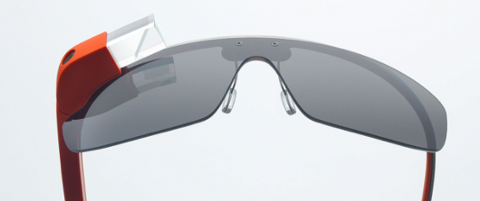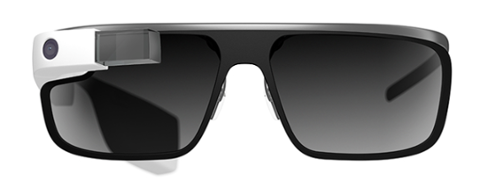http://www.youtube.com/watch?v=1Bbeu_-S0Fo Since I first began wearing it back in July, Google Glass has become an intimate part of my life—something that was easy to forget until I had to send in my old pair for the upgraded version, which took three weeks to arrive. (Blame a December blizzard, followed by the holiday season, then the polar vortex that swept through New York City. Or blame Google packing the device ultra-slowly.) I actually began missing Glass, mostly due to the serendipitous situations I seemed to find myself in. Finally the bright blue wearable computer arrived, and I unpacked it from its white, delicate box. It looked exactly the same as the first-generation device, albeit with an extra accessory: an ear-bud for phone calls and Google Hangouts. And while the hardware looked the same, it was clear that the
XE12 software upgrade added many more features, including an “eye wink” option for snapping photos. It also included enhanced audio recording, auto-focus through video, and hopefully better battery life (or at least less chance of the device overheating near my right side of my head). The problem with troubleshooting any Glass connectivity issues is that you literally have the computer on your head, which translates into a sore neck. Inputting your Internet password and user name is supposed to generate a QR code for Glass to read. I couldn’t get this to work, even after two hours of repeatedly bending down to my computer screen so Glass could read the code. Instead, I went to
Glass headquarters in New York, where Google will assist users in either setting up a newly purchased Glass device or solving problems with an existing unit. The place feels like a very quiet Apple store, and you need to book an appointment before you show up. I am one of the early adopters, which Google calls Explorers. The name in itself is symbolic of my experience using Glass, as it’s allowed me to explore the world in a different way. As the “Glass Guides” fixed my connectivity issue, one of them asked me if I was using Google Now. “Why would I want to?” I asked him. He told me that Google Now can access his flight information, which means that, whenever he lands in a new city, Glass suggests landmarks to visit. That seems lazy, I thought. Doesn’t that take away from exploration? But as I thought about it a little more, I realized that we clearly had different ideas of exploration—his involved having more data, in order to make better decisions on how to move through a new urban jungle. My idea of exploration is to wander the streets, look at the world around me, and feel my way through what catches my attention. Just because other people like taking photographs of landmarks doesn’t mean I want to; maybe a bird or the old alleyway is more interesting to me than a suggested itinerary.
Digital Sidekick
Everyone laughs because my eye wanders as it tries to focus on the Glass display embedded in the right lens. This new version of Glass seems less invasive than the last, although I wonder if I only believe that because this is an upgrade. You tap the device to scroll through screens—you can use that gesture to see all the photos and videos you’ve taken, as well as any texts and emails received and social media messages sent. Is that information overload? Perhaps. But the journalist in me sees it as clever record-keeping. The Glassware store offers a growing number of apps, including the expected ones: Google Play Music, Hangouts, Facebook, and YouTube. There’s also Compass, which allows you to find interesting landmarks; Field Trip, which allows you to walk around and look up local history; Video Voyager, a tool for sharing videos based on your location; and Strava Run, which visualizes your fitness habits. For the beginner chef in me, there’s Allthecooks Recipes, with its database of 150,000 recipes; it displays not only the ingredients, but also step-by-step directions for cooking the requested dish. In all, Glass has 36 apps to choose from; compared to existing ecosystems on Android and iOS, that’s a splash in the bucket. Glass also forces me to adopt more of Google’s products, including Google Plus for sharing media. Having a computer on your head changes how you interact with digital information. For one thing, there’s less physical distance between you and the hardware. You have to speak to Glass to command it; the more I used Glass, the more it felt like I was entering a relationship with it. If the
movie “Her” is any indication of where our relationship is going with technology, then the way we talk to the machines is going to become increasingly intimate.
Signs of What's Coming
Begin by saying “Ok, Glass. Take a photo.” Or just wink an eye, and bam, a picture is taken and ready to share. This is where the privacy concerns come in, and it’s what makes some people nervous. Right now, Google Glass is a novelty: people get excited and yell out, “Oh, she has Google Glass!” when they spot one. But I wonder what the reaction will be once more people are wearing Glass and uploading videos in real time. Is this a future we want? Whenever I wore Glass, was I contributing to the ever-growing surveillance in our digital and actual lives? Was I invading my own privacy even more than that of the people around me? I began to question the nature of public space versus private space, and wondered if I should tell people I’m recording (or have them assume that I am). Having Glass makes being alone more fun sometimes. You can talk to yourself productively, sending messages to friends. By hooking up my iPhone to Glass, I am able to send an email to 10 of my favorite people that I curate on my contact list. (I sent a message to a friend to tell him I was at Google, but the voice activation registered as “hi of Google,” which didn’t make any sense to him when it ended up in his inbox.) I don’t care so much about getting directions or sending text messages through Glass, or accessing Glassware. I really love using the photo- and video-recording function, which has helped me capture more moments of life than before. In the video above, I took Glass around with me on my daily routines such as getting coffee, going to the dentist, and traveling on the subway. Some people approached me. Others stared at me. And more than a few didn’t even notice. With a truly novel tool like Glass, people tend to gaze in awe rather than act fearful. However, that sentiment may change as more people begin to wear devices that can monitor your every public move. (This summer, when I began wearing the first iteration of Glass, I became known as The Google Glass Girl. One day I stopped into an art gallery, where an artist named M. Henry Jones wanted me to film from my perspective as he snapped photos of me for a Fly’s Eye 3D portrait. I’m not famous, but because I had Glass, the artist made my portrait into artwork. Not everyone is as receptive; at a coffee shop, a woman became so uncomfortable at the sight of me wearing Glass that she left.) In a way, Glass is my pet. But I don’t have to worry about feeding it; I just have to make sure that it’s fully charged so that when people ask me to try it on, I don’t have to tell them it’s out of battery. Glass has potential to take off as a new platform because it’s not a phone: the hands-free approach could expand its use to venues as diverse as the operating room and kitchen, unlocking new ways of using the data overlays to augment the real world. As you’ll see in the video, when I wore Google Glass to OST Cafe in the East Village, I met Ben Freda. After Googling him, I was able to tell that he is a Web developer. That’s a very simple thing that Glass can do, and its uses will only grow in coming years. As wearable electronics and augmented-reality headsets such as Oculus Rift evolve into a more mainstream presence, it may become harder and harder to disconnect from devices such as Glass. The closer our minds and machines become to each other, the more our innate cognitive processing can handle the incoming data.
But is the constant digital stream making us less human? I remember when I first began Googling information, soon after the search engine was first launched. Googling removes the cognitive load of having to remember the directions within your city, and allows you to explore your world through maps and indexed places. Glass is the next extension of that functionality, allowing you to seamlessly keep track of data and people—just tap and scroll, and every phone, video, message, call, update, and search is right there in front of you. For the most part, the device is a good prototype for this new kind of computer: but do we really need it, and are we ready for it? The device also takes over as a fashion statement. One friend wrote to me: “I get a strong vibe that you are a robot inside. I'm not sure if that's a nice thing to say, but in seriousness I think it's an interesting way of expressing personality.” At least he didn’t call me a Glasshole? Yes, wearing Glass invites people to judge you on the fact that you are wearing Glass. Strangers come up to you on the street, excited, asking questions about how it works and when it’s coming out. For that reason alone, Glass makes me realize how small the world is, and how connected we really are. I’ve always welcomed random interactions on the street, but with Glass, those interactions become commonplace. (Perhaps that’s what being a celebrity is like.) Yet Glass makes it easy to hide behind the cloak of the wearable gadget. For that reason alone, I tend to leave the device at home when I don’t want all my interactions to focus on it. Glass doesn’t define me, it only enhances my adventures—and it’s getting more advanced, leaning how to better interact with all the available, searchable data in our daily lives. Give it time and perhaps Glass will understand when I say: “ok, glass. get directions to... my heart.”
Images/video: Boonsri Dickinson 

